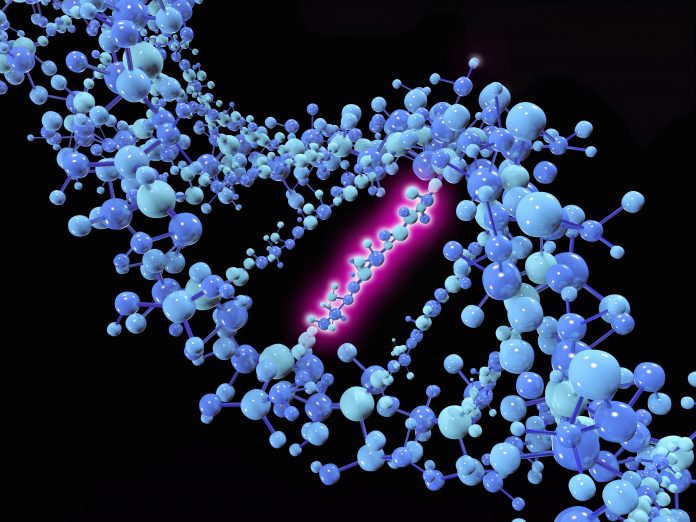In the fast-evolving world of genetic innovation, few leaders embody the spirit of discovery and application like Brad Ringeisen, PhD, executive director of the Innovative Genomics Institute (IGI), does. With a rich career that includes groundbreaking work at the Defense Advanced Research Projects Agency (DARPA), where he spearheaded projects at the intersection of biology and national security, Ringeisen now leads IGI’s mission to harness CRISPR and other cutting-edge technologies to tackle some of humanity’s greatest challenges. In this exclusive interview, Ringeisen shares insights into his transformative vision for the use of advanced genome engineering as personalized medicine worldwide.

This interview has been edited for length and clarity.
Q: What has the IGI set out to accomplish using CRISPR-based gene editing in human health?
Ringeisen: Our vision is personalized medicine for all. It’s an audacious, big vision that we think we can accomplish. However, you can’t accomplish [it] in the manner that private industry is currently pursuing. It’s not affordable or accessible. It can’t be scaled. So, we’ve broken it down into technology, manufacturing, and public impact (which we call framework and scaffold).
On the technology side, there’s two aspects. One is delivery. If we can get to in vivo delivery, you’re talking about potentially one-dose treatment (either IV [intravenous] or shot) to find the right cell and tissue type … and deliver the payloads that can do knock-ins rather than just knock-outs. Many people across UCSF (University of California, San Francisco) and Berkeley are innovating. Jennifer Doudna has created these enveloped delivery vehicles that are encapsulated using viral proteins to help get into cells and target cells.
The second is access. We’re a nonprofit. We also spin out companies. We’re celebrating our 10th anniversary this year and have spun out 26 companies and raised over $3 billion. Part of the equation is companies, but we are at our heart a nonprofit. What’s going on in Silicon Valley and South San Francisco is not going to solve the problems of scaling, affordability, and accessibility of new CRISPR technology and emerging therapeutics. So, we’re innovating to provide CRISPR delivery modalities, patents that the UC system would control that could either be given at very low costs or costs that would be compatible with that vision. This involves AI as well as protein and RNA engineering to make new editing and delivery modalities that potentially could provide more access. We care about the American population, but we also really care about low-income countries, underrepresented groups, and resource-poor settings. I think in vivo [CRISPR gene editing] technologies can really help those individuals.
On the manufacturing side, the issues are the quality control, batch size, and outrageous costs—hundreds of thousands of dollars—to be able to create some of the batches of these GMP (good manufacturing practice)-grade materials. People in the manufacturing industry are saying that there are close replicates of what they could do but wouldn’t technically qualify as GMP in terms of the scale and purity for what is perceived as requirements to achieve safety and efficacy. They check nearly every box, but not everyone needs to be GMP. So, we’re in conversations with the FDA to try to see if there’s some middle ground, especially for these rare diseases where you might have one or two patients that you’re serving. Do you really need to check every single last box that you would need to treat a thousand people? Do you need to check all those boxes to treat one or two people? I think the answer is probably no, and I think the FDA is ultimately going to come around.

Then there’s going to be novel innovations in manufacturing as well as non-viral approaches. If it’s a viral vector, it’s immediately going to be expensive. So, how can we innovate manufacturing technologies that are more chemically driven to create non-viral vectors and do not rely on cell manufacturing? I think our manufacturing partners will beable to do that and reduce the cost of goods.
The last one, framework and scaffold, is really hard. It’s going to take philanthropy, governments, groups of people that have shared common interests, and corporate America to step up and say, “There are people that need these treatments that can’t afford them, either because there’s not enough patients or they’re currently commercially too expensive.” It’s IGI’s goal to do that. How are we going to do it? It’s going to take a lot of work and partnerships. But that’s what we’re hoping to work on for the next several years.
Q: What medical conditions and indications does the IGI have its sights on?
Ringeisen: The first is rare diseases—neglected diseases that aren’t rare if you look globally. The vision is a clinical network with the IGI as the engine, where we are looking at trying to access hundreds, maybe thousands, of those diseases. You’ve got to do that globally. You can’t just do it at UCSF. So, we’re talking to people in the U.K. and Singapore, and we’re already working in Brazil. We’re starting to see this internationalization of the IGI to try to realize that vision of going from one disease to two to ten to more. That’s not a one- or two-year vision. That’s a 10- to 15-year vision.
The second is neuro. If we think of what is underserved and isn’t working well right now and the area of opportunity that an academic research hub like an innovation engine like the IGI can make an impact—it’s neuro. For example, we’re working on Amyotrophic Lateral Sclerosis, Huntington’s, Alzheimer’s, and Parkinson’s. We have a high-throughput system that’s generating models of cells that are going to help inform the next generation of drugs, and the pipeline is pretty bleak. So, what are the steps that need to be worked on? It’s still delivery. The tests that we’ve done in vivo have been direct injection and, I think near-term, direct injection is going to work. You can be precise and target certain regions of the brain. We have delivery modalities that can target specific cell types and diffuse more robustly through the brain to affect more tissue. Then it’s the targets. What are you going to affect change in? Is it regulation of the gene or a wholesale change in the DNA? What types of cells are they, glial cells or neurons? Will you be affecting the glymphatic system? The mechanistic aspect of this is still very challenging.
The last one is cancer. There’s so much money going into cancer, yet I think that CRISPR is the future of cancer, making better CAR Ts with multiplex knockouts or knock-ins in vivo. In general, if you’re looking at CRISPR technology, cancer’s a given; that’s where all the money is.
Q: How are you going to tackle all of the rare diseases?
Ringeisen: I’ll use the Danaher relationship—the new Danaher-IGI Beacon for CRISPR Cures center—as an example. One of our best partners, UCSF, is a leading clinical center in the country. We don’t randomly choose the diseases that we are trying to get to the clinic. When Danaher comes to us and says they want to create a revolving door of cures—to build from one or two to ten to fifty to hundreds to thousands—we still need to start with one or two. So, we choose based on some of the world-leading clinicians that are at UCSF. So, we surveyed our partners at UCSF and we came up with two [clinicians] that are really amazing.
One is Jennifer Puck (MD). Jennifer [Doudna] and Jennifer [Puck] have worked together in the past. Jennifer [Puck] is an expert in Artemis-deficient severe combined immunodeficiency (Artemis-SCID). It’s prevalent in the Navajo and Apache communities. UCSF happens to be the central priority location. If Artemis-SCID patients come in, they go to UCSF. There’s a viral gene therapy for Artemis-SCID in the clinic right now, but it can be improved for cost, safety, and efficacy. We think CRISPR is part of that solution. Secondly, there’s a disease called hemophagocytic lymphohistiocytosis (HLH). It’s a complicated, heterogeneous disease. We are focusing on one variety. It’s also an immune deficiency. Michelle Hermiston, MD, PhD, is an expert at HLH, so we’ve chosen that. The beauty is that these strategies use the same cell type.
For rare diseases, if we can try to basket them together under all those conditions, we can open it up to more and more patients. We’ve talked to the FDA about this, if you can group the same tissue type and editor and just change the CRISPR guide RNA. The FDA is open to playing ball to be able to create either an umbrella or basket that uses the same tissue type, delivery particle, and editor—all we’re doing is changing the guide to target a different disease. The FDA is considering these types of trials, but it is still going to take some time for these types of IND clearances for categories of diseases. If it happens, though, that would be huge. If we can show safety and efficacy and we’re developing all of the tools and the sequencing assays to get the safety and to get the efficacy to build all the data that you need … we’re trying to standardize that with our clinical lab inside the IGI. There’s nothing stopping us then from trying to accelerate and expand to categories of diseases. That’s the stepping stone.
We’re also working with some partners in Brazil to potentially start a sickle cell trial. We want to try to lower the cost of goods and reduce the manufacturing burden in a country like Brazil. I think it’s going to be really important.
Q: What should we expect next from the IGI?
Ringeisen: Jennifer [Doudna] does not sit on her laurels. She’s remarkable in that sense. She could just be touring the world and giving the same talk over again, but that’s not what she wants to do. She’s still got some really big dreams about what she wants to do and she wants to make an impact in the world. The next 10 years are going to be focused on that—how to make a global impact to sustainably feed the world and affordably cure human diseases in populations that need them most.
Jonathan D. Grinstein, PhD, North American editor for Inside Precision Medicine, investigates the most recent research and developments in a wide range of human healthcare topics and emerging trends, such as next-generation diagnostics, cell and gene therapy, genome engineering, and AI/ML for drug discovery for publications like Scientific American and Genetic Engineering and Biotechnology News (GEN). Jonathan earned his PhD in biomedical science from the University of California, San Diego, and a BA in neural science from New York University.









![Best Weight Loss Supplements [2022-23] New Reports!](https://technologytangle.com/wp-content/uploads/2022/12/p1-1170962-1670840878.png)




